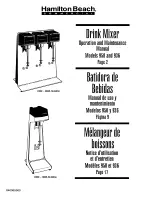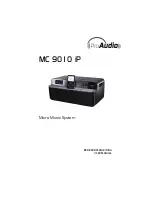
15
EFX Send
This taps the channel’s signal out to either
the internal
EMAC
Digital Stereo Effects
Processor or to an external device via the
EFFECTS SEND
jack for parallel effects pro-
cessing. Each channel’s effects send signal is
controlled by the channel’s
EFX
knob, and the
overall effects send level is controlled by the
EFX DRIVE LEVEL
knob (located in the
EMAC
section).
The effects send signal is post-EQ and post-
VOLUME
, so these controls affect the signal
going to the effects processor, be it internal or
external.
Each
EFX
send control ranges from off
through unity (the center detent position) on
up to +10 dB of extra gain (when turned fully
clockwise). Chances are you’ll never need this
much extra gain, but it’s nice to know it’s there
if you do.
Normally the effects send signal is routed
to the internal
EMAC
Digital Stereo Effects
Processor (more on
EMAC
coming up). However,
if you plug into the
EFFECTS SEND
jack
(located just below the
EMAC
section) you
can send the effects signal to an external
effects device. You can return the signal from
the external effects device by plugging its
output into the
EFFECTS RETURN
jack(s)
just below the
SEND
jack.
This disconnects
the
EMAC
from the internal effects bus.
You mix the amount of effects you want
returned to the main mix by adjusting the
EFX
TO MAIN
control located just above the
MAIN MASTER
. You can also add effects to
the monitor mix by adjusting the
EFX TO
MON
control located just above the
MONITOR MASTER
.
Note:
See “Effects Send and Return” on
page 22 to see how to use
EMAC
and an
external effects processor at the same time.
MON Send
This taps the channel’s signal out to an
external amplifier, which powers your moni-
tor speakers, via the
MONITOR LINE OUT
jack. Each channel’s monitor send signal is
controlled by the channel’s
MON
knob, and
the overall monitor send level is controlled by
the
MONITOR MASTER
control.
The monitor send signal is pre-EQ and pre-
VOLUME
, so if you adjust these controls they will
affect only the main mix and not the monitor mix.
Each
MON
send control ranges from off
through unity (the center detent position) on
up to +15 dB of extra gain.
EMAC Section Description
EMAC™ stands for Extended Multiply and
Accumulate, which is a proprietary 32-bit digital
stereo processor developed by our Digital
Engineering Group. It provides 16 preset digital
effects algorithms for you to select. In addition
to the presets, there are two parameter controls
/
you can adjust to change the sound and
make it unique for your particular application.
EFX BYPASS
EFX DRIVE
LEVEL
12
0
NORMAL
EFX
CLIP
CUSTOM 32-BIT PRECISION
DIGITAL STEREO EFFECTS PROCESSING
EFX WIDE
EFX DRIVE LEVEL
This controls the signal level being sent to
the input of the
EMAC
module (and to the
EFX
SEND
jack). Use the
EFX
controls on the indi-
vidual channels to adjust the amount of each
channel’s signal you want to go to the
EMAC
.
Leave the
EFX DRIVE LEVEL
set at the
NOR-
MAL
position. If you find that you’re not getting
enough of the effect in the main mix, make
sure that the
EFX TO MAIN
control is turned
up at least to unity (the center detent posi-
tion). It’s okay to turn up the
EFX DRIVE
LEVEL
some more if you need to. Just make
sure the
EFX CLIP
LED never lights more than
occasionally. Read on to find out why.
EFX CLIP
This indicates when the
EMAC
is 6 dB
below clipping. This LED should only light
occasionally. If it blinks frequently, you should
turn down the
EFX DRIVE LEVEL
a little.
Digital clipping is not pleasant to behold.
EFX BYPASS
Pushing in this button causes the
EFX
BYPASS
indicator to light and mutes the
effects signal. It affects both the internal
EMAC
effects and any external effects
processor you may have connected to the
EFFECTS RETURN
jack.
EFX
MON
HI
12kHz
MID
2.5kHz
LOW
80Hz
VOLUME CH.
1
INPUT
LEVEL
SET
MIC
1
INSERT
LINE
U
O
O
+10
U
+15
-15
U
+15
-15
U
+12
-12
1
U
+20dB
O
O
HI
LOW
NORMAL
U
O
O
+15
Mono Version
Channel Strip





































